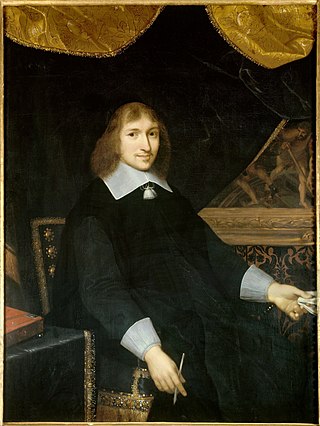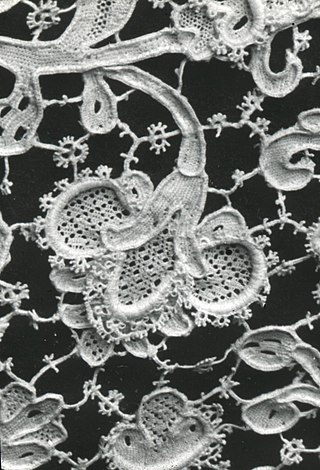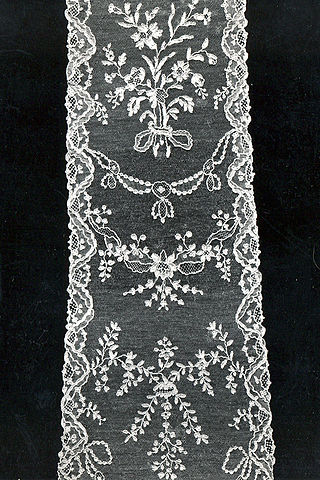
Louis XIV, also known as Louis the Great or the Sun King, was King of France from 1643 until his death in 1715. His verified reign of 72 years and 110 days is the longest of any sovereign. An emblematic character of the Age of Absolutism in Europe, Louis XIV's legacy is widely characterized by French colonial expansion, the conclusion of Eighty Years' War involving the Habsburgs, and his architectural bequest, marked by commissioned works of art and buildings. His pageantry, opulent lifestyle and ornate cultivated image earned him enduring admiration. Louis XIV raised France to be the exemplar nation-state of the early modern period, and established a cultural prestige which lasted through the subsequent centuries until today.

Lace is a delicate fabric made of yarn or thread in an open weblike pattern, made by machine or by hand. Generally, lace is split into two main categories, needlelace and bobbin lace, although there are other types of lace, such as knitted or crocheted lace. Other laces such as these are considered as a category of their specific craft. Knitted lace, therefore, is an example of knitting. This article considers both needle lace and bobbin lace.

Nicolas Fouquet, marquis de Belle-Île, vicomte de Melun et Vaux was the Superintendent of Finances in France from 1653 until 1661 under King Louis XIV. He had a glittering career, and acquired enormous wealth. He fell out of favor, accused of peculation and lèse-majesté. The king had him imprisoned from 1661 until his death in 1680.

Jean-Baptiste Colbert was a French statesman who served as First Minister of State from 1661 until his death in 1683 under the rule of King Louis XIV. His lasting impact on the organization of the country's politics and markets, known as Colbertism, a doctrine often characterized as a variant of mercantilism, earned him the nickname le Grand Colbert.

Needle lace is a type of lace created using a needle and thread to create hundreds of small stitches to form the lace itself.

Charles Le Brun was a French painter, physiognomist, art theorist, and a director of several art schools of his time. He served as a court painter to Louis XIV, who declared him "the greatest French artist of all time". Le Brun was a dominant figure in 17th-century French art and was influenced by Nicolas Poussin.

Events from the 1680s in Canada.

Charles Antoine Coysevox, was a French sculptor in the Baroque and Louis XIV style, best known for his sculpture decorating the gardens and Palace of Versailles and his portrait busts.

Point de Venise is a Venetian needle lace from the 17th century characterized by scrolling floral patterns with additional floral motifs worked in relief. By the mid-seventeenth century, it had overtaken Flemish lace as the most desirable type of lace in contemporary European fashion.

Alençon lace or point d'Alençon is a needle lace that originated in Alençon, France. It is sometimes called the "Queen of lace." Lace making began in Alençon during the 16th century and the local industry was rapidly expanded during the reign of Louis XIV by Jean-Baptiste Colbert, who established a Royal Workshop in the town to produce lace in the Venetian style in 1665. The purpose of establishing this workshop was to reduce the French court's dependence on expensive foreign imports. Marthe La Perrière had modified the Venetian technique and Alençon emerged as a unique style around 1675 after Colbert's monopoly ended. The lace employs a mesh ground and incorporates pattern motifs with a raised outline of closely packed buttonhole stitches, an outer edge decorated with picots, and open areas with decorative fillings.

Reticella is a needle lace dating from the 15th century and remaining popular into the first quarter of the 17th century.
Colbertism is an economic and political doctrine of the 17th century, created by Jean-Baptiste Colbert, the Controller-General of Finances under Louis XIV of France. Colbertism is a variant of mercantilism that is sometimes seen as its synonym. It is more a collection of economical practices than a true current of economic thought.

17th-century French art is generally referred to as Baroque, but from the mid- to late 17th century, the style of French art shows a classical adherence to certain rules of proportion and sobriety uncharacteristic of the Baroque as it was practiced in most of the rest of Europe during the same period.

Absolute monarchy in France slowly emerged in the 16th century and became firmly established during the 17th century. Absolute monarchy is a variation of the governmental form of monarchy in which the monarch holds supreme authority and where that authority is not restricted by any written laws, legislature, or customs. In France, Louis XIV was the most famous exemplar of absolute monarchy, with his court central to French political and cultural life during his reign. It ended in May 1789 during the French Revolution, when widespread social distress led to the convocation of the Estates-General, which was converted into a National Assembly in June 1789. The National Assembly passed a series of radical measures, including the abolition of feudalism, state control of the Catholic Church and extending the right to vote. The king of France was an absolute monarch.

The Church of St. Eustache, Paris, is a church in the 1st arrondissement of Paris. The present building was built between 1532 and 1633.

Blois Cathedral, or the Cathedral of St. Louis of Blois, is a Late Gothic Catholic cathedral in Blois, France. It has been a monument historique since 1906.

Villeneuvette is a commune in the Hérault department in the Occitanie region in southern France. It is close to the town of Clermont l'Hérault.

Brussels lace is a type of pillow lace that originated in and around Brussels. The term "Brussels lace" has been broadly used for any lace from Brussels; however, strictly interpreted, the term refers to bobbin lace, in which the pattern is made first, and the ground, or réseau added, also using bobbin lace. Brussels lace is not to be confused with Brussels point, which is a type of needle lace, though sometimes also called "Brussels lace".

The Louis XIV style or Louis Quatorze, also called French classicism, was the style of architecture and decorative arts intended to glorify King Louis XIV and his reign. It featured majesty, harmony and regularity. It became the official style during the reign of Louis XIV (1643–1715), imposed upon artists by the newly established Académie royale de peinture et de sculpture and the Académie royale d'architecture. It had an important influence upon the architecture of other European monarchs, from Frederick the Great of Prussia to Peter the Great of Russia. Major architects of the period included François Mansart, Jules Hardouin-Mansart, Robert de Cotte, Pierre Le Muet, Claude Perrault, and Louis Le Vau. Major monuments included the Palace of Versailles, the Grand Trianon at Versailles, and the Church of Les Invalides (1675–1691).
Marthe La Perrière, born Barbot, was born c.1605 in Alençon, France, where she died on January 12, 1677. She is the inventor of the "point d'Alençon", or Alençon lace.



















